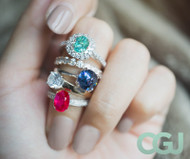Choosing A Gemstone Ring
Posted by Mariel Baker on 19th Nov 2021
Choosing A Gemstone Ring
For millennia, people adored and prized colored gemstones. Then, in the 1920s, De Beers changed all that by marketing the diamond as the symbol of forever love, and diamond engagement rings became the tradition. When Princess Diana chose a blue sapphire for her engagement ring, people began choosing rubies, sapphires, emeralds, spinels, etc. for their engagement rings as an alternative. As mining has increased, more gemstone species were found, and more choices became available for beautiful gemstone jewelry. Today, there are many choices for rings – everyday rings and special occasion rings in many colors. It's important to know which is best choice for you.
Engagement Ring Gemstones
The first decision you need to make is whether you want a traditional diamond ring, or an alternative engagement ring featuring a colored gemstone.
Traditional Diamond Rings
Diamonds come in a variety of colors, shapes, sizes and cuts. Some people want more perfect diamonds – better clarity, cut and color over size. The larger the diamond, the higher the price – unless it has a lot of inclusions or the color isn’t good, which will be far less expensive but noticeably poor quality. Colorless diamonds - or ‘D’, ‘E’, ‘F’ colors and IF (Internally Flawless), VVS (Very, Very Slight inclusions), VS (Very Slight inclusions) being best (and most expensive) clarity. When talking to a competent jeweler, once they know your budget, they can recommend several options for you.
Diamonds vs. Colored Gemstones
Diamonds are graded by using a 10x loupe. Colored gemstones are graded without any loupe or magnification – just by the unaided eye. The clarity ‘SI’ (Slight Inclusion) in diamonds can be very clear to your eyes without a loupe, and conversely, ‘SI’ in a colored gemstone will show some inclusions to the unaided eye. Obviously, the better the clarity the higher the sparkle and the price.
Beyond the 4 Cs - Hardness
Everyone knows: carat weight, color, clarity and cut but there’s another important factor to consider. When choosing a colored gemstone as an everyday or engagement ring, hardness is critical to making the right choice. All gemstones are measured on the Mohs’ scale of harness – 10 being the hardest (which is a diamond). A common misconception is that diamonds are impervious to scratching, chipping and breaking (I’ve broken a few myself). A colored gemstone’s hardness varies widely by species, cut and clarity. Sapphires and Rubies (corundum species) are very hard - 9 on Mohs’, with rare gemstones such as Chrysoberyl (Alexandrite being a color change variety of the Chrysoberyl species) landing at 8.5 on the Mohs’ scale. Beautiful Spinel, rare Phenakite and Topaz are 8, while the Beryl species are 7.5 to 8. Beryls are: Emeralds, Morganites, Aquamarines, Heliodors, etc. Emeralds can be tricky – they are considered a Type 3 gemstone and usually have a lot of inclusions. The more included, the less durable they can be regardless of their hardness.
Other durable, popular gemstones are: Garnets (most are 7.5, other types of Garnets are 7), natural Zircons, Danburites Oregon Sunstones and Tourmalines – all measuring 7.5 on Mohs’. Amethyst, Citrine, Kunzite, Peridot, and Quartz are 7 on Mohs’. Less durable are the very beautiful and popular Opals and
Tanzanites, at 6.5 on Mohs’. These are considered good gemstone rings but we don’t recommend everyday wear. There is a species of Opal that are more durable – the Australian Mintabie Opal which generally is between 7.5 to 8 on the Mohs’ scale. Another gemstone, Kyanite, if cut properly will have a hardness of 7; if cut along its axis will have a very soft hardness of 4.
Pearls, Turquoise, Malachite, Apatite, Coral, Chrome Diopside, Rhodochrosite, etc. are softer and should be only considered for ‘special occasion’ jewelry.
Choosing Gemstones
Some people choose gemstones based upon their birthstone, while others just want their favorite color. People are always amazed when they come into our store and we show them that Sapphires, Spinels, Garnets, Tourmalines, etc. come in rainbows of colors. So it’s possible to get your birthstone and your favorite color in one gemstone.
Typically, for an everyday ring, we recommend a gemstone with a Mohs’ hardness of 7 or better. If you are hard on your jewelry, then we recommend 7.2 or higher.
We currently have more than 43 species of gemstones, and every color of the rainbow to choose from. If in doubt about a gemstone, just ask us. The setting can protect and also can put your gemstone at risk of fracture – even diamonds. A knowledgeable jeweler can help you decide which is best for you.
TIP: proper way to remove your ring: Remember that with a prong-set gemstone, the prongs are metal. If you take your rings off with your thumb on top of the gemstone, you will loosen it eventually. You should remove your ring by its sides.

